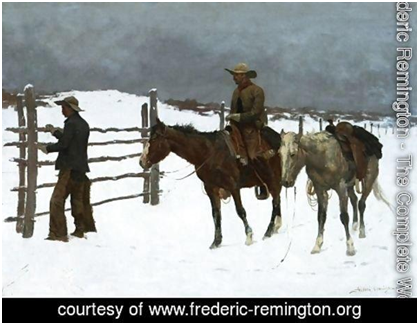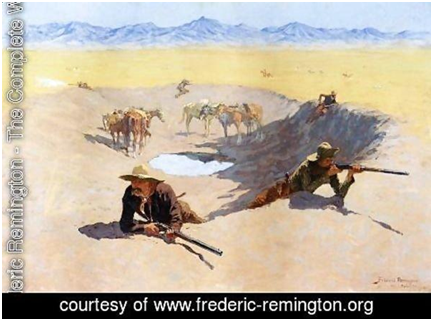Frederick Remington is an American artist in a style of impressionism, illustrator, sculptor, writer, and poet. The main theme of his creations was the image of the old American West. The heroes of his stories and paintings were often cowboys, American Indians, and cavalry and cavalry charge.
Remington was born in 1861 in Canton, New York, in a family of emigrants from the German Empire.
Remington’s father was a colonel in the civil war between the Northern Territory and the South. The father’s family came to the United States from England. He was a convinced Republican. The family tree of Frederick Remington was associated with native American artist – George Catlin and the sculptor – Earl W. Basque.
A Dash for the Timber

Remmington’s most famous work is rightfully considered A Dash for the Timber. 28-year-old Remmington created this painting under the indelible impression of traveling through the American “wild” west.
The advent of A Dash for the Timber was preceded by sketches for popular magazines such as Outing and The Century Magazine. Published in magazines in the style of a documentary film on the conquest of the wild west, he soon acquired an army of admirers of his work. Even President Roosevelt himself was carried away with his sketches.
Thus, Dash for the Timber is an example of the culmination of the “small creations” of the ambitious youthful Remington. In American painting of the second half of the 19th century, the religious themes dominated. But Remington made the depiction of national objects and historical subjects popular.
After Remington established himself in the role of the most popular America magazine illustrator, he focused on large-scale cowboy paintings depicting life in the American West.
The Fall Of The Cowboy By Frederic Remington

The Fall Of The Cowboy is an illustration of the life details of life in the American West. It is a distinctly accurate reproduction of life in the American West. The propaganda of Remington’s life in the “wild” west was an impression of life itself. It increasingly depicted how its modern North observed the unpleasant and wild South.
However, The Fall Of The Cowboy is an exceptional wreckage archive in the west that represents the brave and terrifying people of the south. The picture depicts a world filled with provincial reality in a rapidly developing and modernizing country. The fence is a symbol of unreasonable redistribution of land and property.
This painting was an illustration of Owen Whister’s article, The Evolution of the Cow Puncher, published in Harper’s New Monthly Magazine, September 1895. After the terrible civil war, the need arose to revive the values of the American dream. Remington’s large-scale canvas further strengthened the mythologization of the West and. As a result, it created the legends of the life of cowboys.
Fight for the Water Hole

The painting The Battle of the Water Hole was painted in 1903. Remington considered the West to be the territory of risk and struggle.
In the picture, a water hole is not just a puddle. Water is like an oasis in a vast desert which makes it a strong argument for its defense. Brave men and their horses are sitting in a pit. They are ready to shoot at any moment to protect their only means of survival at the moment.
The picture is divided into large color fragments. Each of these fragments can be observed separately and as if completing a task to find and delve into small elements.
In the center of the plot is a water hole. And no matter how huge it seemed in the framework of the canvas, it is microscopic in terms of landscape. The shadow on the side of the hole will mark the proximity of the sunset, which makes our heroes more vulnerable.
Aiding a Comrade

Remington directs the observer’s gaze to the foreground, where people and horses are located. Horses turned outward, frame, and highlight the central figure, which is even more clearly visible due to the blurry background.
The painting strikes the artist’s attention to the smallest details. Clothing, hard equipment, weapons – everything gives us a deep idea of the realism of the scene taking place in the wild west.
The author depicts the Indians much lower, with less detail and faded colors. Remington’s style, using quick and short strokes, shows the influence of French impressionism. It is based on emphasizing color, shadow, and light.
In the center of the painting Aiding a Comrade is a scene with a dramatic plot. While riding, a cowboy fell from the central horse. His friends are trying to keep the horse fallen and prevent him from being trampled.
Cold Morning on the Range

The picture shows a man on a big horse. Apparently, the horse is wild and not tamed to obey the owner. It jumps and puts the brave rider at great risk. The other people in the background are also with horses. Most likely they drive cattle to pasture. The mountains are surrounded by snow-white clouds. Many observers suggest that the mountains are part of the famous Sierra Nevada cattle range. Throughout the picture, the artist uses a lot of yellow to emphasize the aridity of the climate.
In Cold morning on the Range, the artist emphasizes the theme of human superiority over nature. There is an assumption that the main character of the picture is a shepherd. We see traditional shepherd’s clothes on him. There is no hat on his head, but cowboy boots and a tarpaulin shirt. The guy produces the impression of a very brave and experienced rider. He confidently sits in the saddle and cleverly copes with the horse’s burrow thanks to the reins. We may suggest that his companions are watching him, but they are at a great distance and it is difficult to see their faces.
Over his life, Frederic Remington has written many cowboy paintings, many of which are stored at the Remington Memorial of the Arts, in Ogdensburg, New York. His work can also be seen at the Art Institute in Chicago, the Whitney Gallery of Western Art, the Metropolitan Museum of Art, and the Amon Carter Museum of Western Art.

